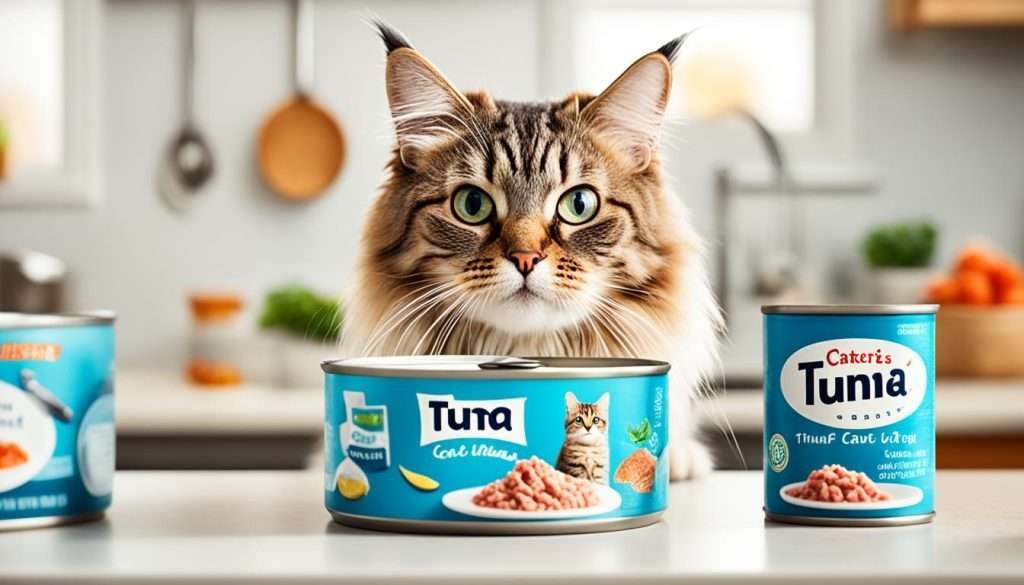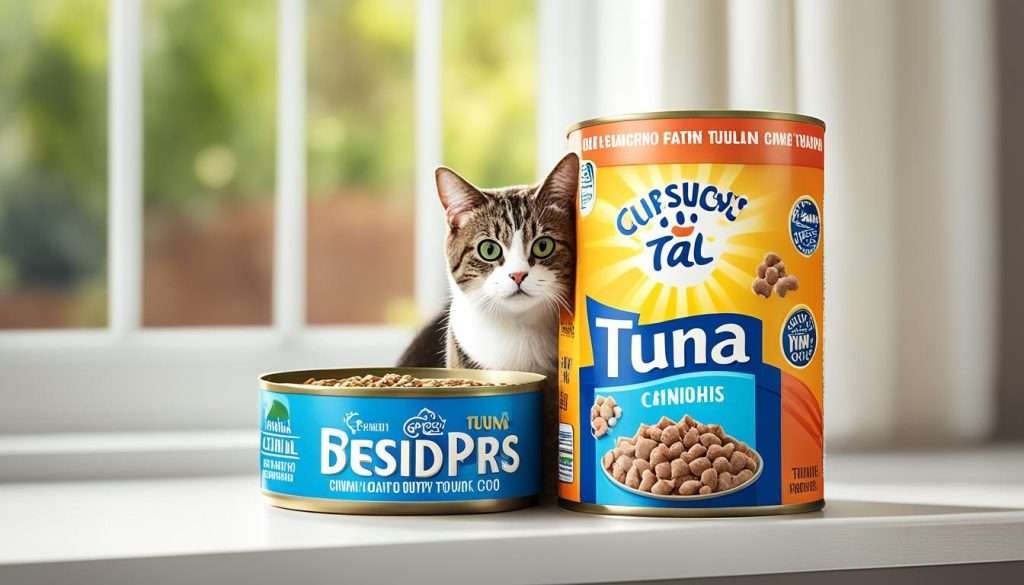Can I feed my cat canned tuna? Cats love the smell and taste of tuna, making many wonder if it’s safe for them. This article looks into the good and bad of giving tuna to cats. It also gives tips on how to safely add tuna to their diet. We’ll cover how cats need meat, mercury poisoning, and thiamine deficiency risks.

Key Takeaways
- Tuna can be a healthy treat for cats, but it shouldn’t be a big part of their diet.
- Canned tuna is safer for cats than raw fish because the canning process removes thiaminase, an enzyme that destroys vitamin B1.
- Tuna has a lot of mercury and can cause vitamin E deficiencies. This can lead to health problems like mercury poisoning and yellow fat disease.
- Some cats might be allergic or intolerant to tuna, causing skin or stomach issues.
- Tuna should only be about 10% of a cat’s daily calories, with the rest from a balanced cat food.
Introduction to Feeding Tuna to Cats
Cats need animal-based protein in their diet because they are obligate carnivores. Tuna can be a great addition, offering high-quality protein and omega-3 fatty acids. But, it’s important to know how tuna fits into a balanced diet for cats.
Cats as Obligate Carnivores
Cats are obligate carnivores, meaning they depend on animal-based nutrients. They don’t have the enzymes to digest plant proteins and carbs well. So, their diet needs are quite different from other animals.
Nutritional Value of Tuna for Cats
Tuna is a top-notch protein source for cats, with all the amino acids they need. It’s also packed with omega-3 fatty acids, which can help reduce inflammation and boost health. But, it’s key to be aware of the risks and limits of giving tuna to cats.
“Cats are obligate carnivores, meaning they require a regular source of animal-based protein in their diet.”
Safe Types of Tuna for Cats
When thinking about fresh tuna for cats or canned tuna for cats, picking the right type is key. Fresh, unseasoned tuna is safer than canned tuna for cats, as long as it’s cooked right. Avoid canned tuna packed in brine or oil because it has too much salt and fat, which can upset a cat’s stomach. The best canned tuna is the kind packed in fresh water.
Fresh Tuna vs. Canned Tuna
Fresh tuna is better for cats than canned because it’s less processed and has fewer additives. But, make sure the fresh tuna is cooked well to kill the enzyme thiaminase. This enzyme can cause thiamine deficiency in cats. Canned tuna is safer because it’s already cooked and doesn’t have thiaminase.
Avoiding Brine and Oil-Packed Tuna
- Tuna in brine has too much sodium, which can harm a cat’s health by causing high blood pressure and kidney problems.
- Oil-packed tuna is bad for cats because the oils can make their stomach upset and lead to weight gain.
- The safest canned tuna for cats is the kind packed in fresh water. It has fewer additives and less sodium and fat.
| Tuna Type | Suitability for Cats |
|---|---|
| Fresh, Cooked Tuna | Suitable, as long as it is properly cooked to destroy thiaminase |
| Canned Tuna in Water | Suitable, as the canning process eliminates thiaminase |
| Canned Tuna in Brine | Not Suitable, due to high sodium content |
| Canned Tuna in Oil | Not Suitable, due to high fat content |
Knowing the differences between fresh and canned tuna, and the risks of brine and oil-packed tuna, helps cat owners make safe choices. They can then add this healthy protein to their cat’s diet safely.
Benefits and Risks of Feeding Tuna to Cats
Tuna can be good for a cat’s diet, offering protein and omega-3 fatty acids. These nutrients support healthy skin, a shiny coat, and overall health. But, pet owners should know the risks of giving tuna to their cats.
Protein and Omega-3 Content
Tuna is packed with high-quality protein, vital for a cat’s growth and muscle health. It also has omega-3 fatty acids that help reduce inflammation and support heart health.
Raw vs. Cooked Tuna
Raw tuna might look appealing, but it can have thiaminase, an enzyme that causes thiamine deficiency in cats. This can lead to serious health problems like neurological issues and heart conditions. To avoid this, it’s best to give cats cooked tuna, as cooking destroys thiaminase.
Thiamine Deficiency and Mercury Poisoning
Tuna also has traces of mercury, which can be dangerous if eaten too much. Mercury poisoning in cats can cause lack of coordination, tremors, and seizures. Owners should watch their cat’s tuna intake and talk to a vet to keep their pet safe.
| Benefit | Risk |
|---|---|
| High-quality protein | Mercury poisoning |
| Omega-3 fatty acids | Thiamine deficiency |
| Supports skin and coat health | Feeding difficulties and picky eating |
Feeding tuna to cats should be done with care. Tuna should be an treat, not the main food. Owners should know the benefits and risks of tuna for their pets.

“Tuna can be a healthy treat for cats when consumed in moderation, but pet owners should be aware of the potential risks and consult with a veterinarian to ensure their feline friend’s safety and well-being.”
can i feed my cat canned tuna
Moderation is Key
Cats might love the taste of tuna, but it’s important to give it in small amounts. Too much tuna can cause weight gain and lead to health issues. Experts say tuna should be less than 10% of a cat’s daily food.
The rest of their diet should be high-quality, complete cat food. This balance is key for their health.
Avoiding Food Aversions and Allergies
Feeding tuna can also cause allergies in some cats. Signs include itching, rashes, vomiting, or diarrhea. If your cat shows these signs after eating tuna, stop giving it to them and talk to a vet.
Use canned tuna in water for your cat. This type avoids added salt and oil. Make sure to cook fresh tuna well to remove harmful bacteria and parasites.
While tuna can be a nice treat, give it in small amounts. It should be part of a balanced diet. Being careful and aware of risks helps keep your cat safe and healthy.

| Statistic | Value |
|---|---|
| Tuna should make up less than 10% of a cat’s daily caloric intake | 10% |
| Remaining 90% of a cat’s diet should come from high-quality cat food | 90% |
| Signs of mercury poisoning in cats include incoordination, loss of balance, and walking difficulties | 3 symptoms |
| Canned tuna packed in water is recommended for cats, avoiding tuna packed in oil or with added salt or flavorings | Canned tuna in water |
By following these guidelines, pet owners can safely give tuna as an occasional treat. This ensures their cat stays healthy and happy.
Incorporating Tuna into Your Cat’s Diet
As a cat owner, you might want to give your cat some tuna from your meal. But, it’s key to know how to add tuna safely to their diet. This ensures they stay healthy and happy.
Tuna as a Topper or Treat
Tuna can be a great addition to your cat’s meals, but don’t overdo it. Cats need a balanced diet because they are obligate carnivores. You can give tuna as an tuna as cat treat or mix it in with their regular food for some variety.
Choose tuna packed in water, not oil or brine, to avoid too much fat and sodium. Start with a little tuna and watch for any signs of upset stomach or allergies.
Commercial Cat Foods with Tuna
For an easy way to add tuna to your cat’s diet, try cat food with tuna. Many trusted brands offer formulas with tuna as the main protein. This gives your cat a complete and tasty meal.
When picking cat food with tuna, read the label well. Choose a product that fits your cat’s needs, like their life stage and health concerns. Talk to your vet if you’re unsure about adding tuna to your cat’s diet.
Remember, tuna can be a tasty and healthy treat for your cat, but don’t give too much. By knowing the good and bad of tuna for cats, you can make sure they enjoy it safely. This keeps them healthy and happy.
Conclusion
Cats love tuna, but pet owners should know the good and bad of giving it to them. Choosing the right type of tuna and giving it in small amounts is key. This way, cats can enjoy tuna as a special treat without harm.
Canned tuna should be a rare treat, not a daily food. It can be too salty and contain mercury, which is bad for cats. Too much tuna can cause stomach problems, nutritional issues, and even mercury poisoning. Owners should watch for signs of fish allergies in their cats.
Plain tuna in water is the safest choice for cats. Give them only a small amount, like a teaspoon or two, based on their size. Tuna should not replace their main food. It’s better as a special treat or to make their regular food tastier.


